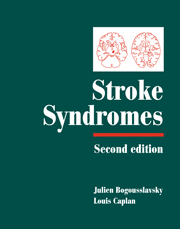Book contents
- Frontmatter
- Contents
- List of contributors
- Preface
- PART I CLINICAL MANIFESTATIONS
- 1 Stroke onset and courses
- 2 Clinical types of transient ischemic attacks
- 3 Hemiparesis and other types of motor weakness
- 4 Sensory abnormality
- 5 Cerebellar ataxia
- 6 Headache: stroke symptoms and signs
- 7 Eye movement abnormalities
- 8 Cerebral visual dysfunction
- 9 Visual symptoms (eye)
- 10 Vestibular syndromes and vertigo
- 11 Auditory disorders in stroke
- 12 Abnormal movements
- 13 Seizures and stroke
- 14 Disturbances of consciousness and sleep–wake functions
- 15 Aphasia and stroke
- 16 Agitation and delirium
- 17 Frontal lobe stroke syndromes
- 18 Memory loss
- 19 Neurobehavioural aspects of deep hemisphere stroke
- 20 Right hemisphere syndromes
- 21 Poststroke dementia
- 22 Disorders of mood behaviour
- 23 Agnosias, apraxias and callosal disconnection syndromes
- 24 Muscle, peripheral nerve and autonomic changes
- 25 Dysarthria
- 26 Dysphagia and aspiration syndromes
- 27 Respiratory dysfunction
- 28 Clinical aspects and correlates of stroke recovery
- PART II VASCULAR TOPOGRAPHIC SYNDROMES
- Index
- Plate section
19 - Neurobehavioural aspects of deep hemisphere stroke
from PART I - CLINICAL MANIFESTATIONS
Published online by Cambridge University Press: 17 May 2010
- Frontmatter
- Contents
- List of contributors
- Preface
- PART I CLINICAL MANIFESTATIONS
- 1 Stroke onset and courses
- 2 Clinical types of transient ischemic attacks
- 3 Hemiparesis and other types of motor weakness
- 4 Sensory abnormality
- 5 Cerebellar ataxia
- 6 Headache: stroke symptoms and signs
- 7 Eye movement abnormalities
- 8 Cerebral visual dysfunction
- 9 Visual symptoms (eye)
- 10 Vestibular syndromes and vertigo
- 11 Auditory disorders in stroke
- 12 Abnormal movements
- 13 Seizures and stroke
- 14 Disturbances of consciousness and sleep–wake functions
- 15 Aphasia and stroke
- 16 Agitation and delirium
- 17 Frontal lobe stroke syndromes
- 18 Memory loss
- 19 Neurobehavioural aspects of deep hemisphere stroke
- 20 Right hemisphere syndromes
- 21 Poststroke dementia
- 22 Disorders of mood behaviour
- 23 Agnosias, apraxias and callosal disconnection syndromes
- 24 Muscle, peripheral nerve and autonomic changes
- 25 Dysarthria
- 26 Dysphagia and aspiration syndromes
- 27 Respiratory dysfunction
- 28 Clinical aspects and correlates of stroke recovery
- PART II VASCULAR TOPOGRAPHIC SYNDROMES
- Index
- Plate section
Summary
Introduction
The discussion of the role of subcortical structures in language and other higher nervous functions begins with the famous polemic opposing Dejerine (a corticalist) to Pierre Marie, who described several anatomico-clinical cases of subcortical strokes causing aphasia, and claimed that damage to an area including the insula and external capsule was crucial to the production of anarthria. However, during the next decades, few authors attributed any role to the thalamus or to other subcortical structures in relation to symbolic and cognitive behaviour. Since the widespread use of modern neuroimaging techniques, it has become evident that aphasia and other ‘cortical’ syndromes can result from lesions limited to subcortical structures. Both single-photon-emission computed tomography (SPECT) and positron-emission tomography (PET) have shown that subcortical strokes are accompanied by important abnormalities of cortical metabolism and perfusion. Magnetic resonance (MR) can demonstrate cortical lesions that were not apparent on CT. These facts raise the question as to whether neurobehavioural disturbances seen after subcortical strokes are due to subcortical damage perse or are related to functional cortical inactivation (diaschisis), to cortical hypoperfusion or to subtle concomitant cortical lesions.
Subcortical aphasia–striatocapsular aphasia
Damasio et al. (1982) and Naeser et al. (1982) described the first patients with subcortical aphasia correlated with CT. Transcortical motor aphasia produced by small ischemic lesions of the basal ganglia, was first described by Wallesch et al. (1983). All of those authors stressed the difficulty of classifying subcortical aphasia in terms of the classic cortical aphasia syndromes (Table 19.1).
- Type
- Chapter
- Information
- Stroke Syndromes , pp. 252 - 263Publisher: Cambridge University PressPrint publication year: 2001
- 1
- Cited by



